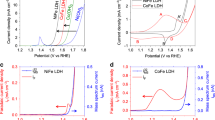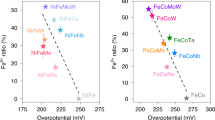Abstract
The efficiency with which renewable fuels and feedstocks are synthesized from electrical sources is limited at present by the sluggish oxygen evolution reaction (OER) in pH-neutral media. We took the view that generating transition-metal sites with high valence at low applied bias should improve the activity of neutral OER catalysts. Here, using density functional theory, we find that the formation energy of desired Ni4+ sites is systematically modulated by incorporating judicious combinations of Co, Fe and non-metal P. We therefore synthesized NiCoFeP oxyhydroxides and probed their oxidation kinetics with in situ soft X-ray absorption spectroscopy (sXAS). In situ sXAS studies of neutral-pH OER catalysts indicate ready promotion of Ni4+ under low overpotential conditions. The NiCoFeP catalyst outperforms IrO2 and retains its performance following 100 h of operation. We showcase NiCoFeP in a membrane-free CO2 electroreduction system that achieves a 1.99 V cell voltage at 10 mA cm–2, reducing CO2 into CO and oxidizing H2O to O2 with a 64% electricity-to-chemical-fuel efficiency.
This is a preview of subscription content, access via your institution
Access options
Access Nature and 54 other Nature Portfolio journals
Get Nature+, our best-value online-access subscription
$29.99 / 30 days
cancel any time
Subscribe to this journal
Receive 12 print issues and online access
$259.00 per year
only $21.58 per issue
Buy this article
- Purchase on Springer Link
- Instant access to full article PDF
Prices may be subject to local taxes which are calculated during checkout



Similar content being viewed by others
References
Lin, S. et al. Covalent organic frameworks comprising cobalt porphyrins for catalytic CO2 reduction in water. Science 349, 1208–1213 (2015).
Goeppert, A., Czaun, M., Jones, J. P., Surya Prakash, G. K. & Olah, G. A. Recycling of carbon dioxide to methanol and derived products—closing the loop. Chem. Soc. Rev. 43, 7995–8048 (2014).
Schreier, M. et al. Efficient photosynthesis of carbon monoxide from CO2 using perovskite photovoltaics. Nat. Commun. 6, 7326 (2015).
Costentin, C., Drouet, S., Robert, M. & Saveant, J. M. A local proton source enhances CO2 electroreduction to CO by a molecular Fe catalyst. Science 338, 90–94 (2012).
Bediako, D. K. et al. Structure–activity correlations in a nickel-borate oxygen evolution catalyst. J. Am. Chem. Soc. 134, 6801–6809 (2012).
Kanan, M. W. & Nocera, D. G. In situ formation of an oxygen-evolving catalyst in neutral water containing phosphate and Co2+. Science 321, 1072–1075 (2008).
Joya, K. S., Joya, Y. F. & de Groot, H. J. M. Ni-based electrocatalyst for water oxidation developed in-situ in a HCO3−/CO2 system at near-neutral pH. Adv. Energy Mater. 4, 1301929 (2014).
Vargas-Barbosa, N. M., Geise, G. M., Hickner, M. A. & Mallouk, T. E. Assessing the utility of bipolar membranes for use in photoelectrochemical water-splitting cells. ChemSusChem 7, 3017–3020 (2014).
Hernández-Pagán, E. A. et al. Resistance and polarization losses in aqueous buffer–membrane electrolytes for water-splitting photoelectrochemical cells. Energy Environ. Sci. 5, 7582–7589 (2012).
Chen, J. Y. et al. Operando analysis of NiFe and Fe oxyhydroxide electrocatalysts for water oxidation: detection of Fe4+ by Mossbauer spectroscopy. J. Am. Chem. Soc. 137, 15090–15093 (2015).
Bergmann, A. et al. Reversible amorphization and the catalytically active state of crystalline Co3O4 during oxygen evolution. Nat. Commun. 6, 8625 (2015).
Bediako, D. K., Surendranath, Y. & Nocera, D. G. Mechanistic studies of the oxygen evolution reaction mediated by a nickel-borate thin film electrocatalyst. J. Am. Chem. Soc. 135, 3662–3674 (2013).
Zaffran, J. & Toroker, M. C. Designing efficient doped NiOOH catalysts for water splitting with first principles calculations. ChemistrySelect 1, 911–916 (2016).
Zaffran, J. & Toroker, M. C. Benchmarking density functional theory based methods to model NiOOH material properties: Hubbard and van der Waals corrections vs hybrid functionals. J. Chem. Theory. Comput. 12, 3807–3812 (2016).
Li, N ., Bediako, D. K., Hadt, R. G. et al. Influence of iron doping on tetravalent nickel content in catalytic oxygen evolving films. Proc. Natl Acad. Sci. USA 114, 1486–1491 (2017).
Bajdich, M., Garcia-Mota, M., Vojvodic, A., Norskov, J. K. & Bell, A. T. Theoretical investigation of the activity of cobalt oxides for the electrochemical oxidation of water. J. Am. Chem. Soc. 135, 13521–13530 (2013).
Persson, K. A., Waldwick, B., Lazic, P. & Ceder, G. Prediction of solid-aqueous equilibria: scheme to combine first-principles calculations of solids with experimental aqueous states. Phy. Rev. B 85, 235438 (2012).
Smith, R. D. & Berlinguette, C. P. Accounting for the dynamic oxidative behavior of nickel anodes. J. Am. Chem. Soc. 138, 1561–1567 (2016).
Zhang, B. et al. Homogeneously dispersed, multimetal oxygen-evolving catalysts. Science 352, 6283–6288 (2016).
Gong, M. et al. An advanced Ni-Fe layered double hydroxide electrocatalyst for water oxidation. J. Am. Chem. Soc. 135, 8452–8455 (2013).
Diaz-Morales, O., Ledezma-Yanez, I., Koper, M. T. M. & Calle-Vallejo, F. Guidelines for the rational design of Ni-based double hydroxide electrocatalysts for the oxygen evolution reaction. ACS Catal. 5, 5380–5387 (2015).
Wang, H. et al. Bifunctional non-noble metal oxide nanoparticle electrocatalysts through lithium-induced conversion for overall water splitting. Nat. Commun. 6, 7261 (2015).
Suntivich, J., May, K. J., Gasteiger, H. A., Goodenough, J. B. & Shao-Horn, Y. A perovskite oxide optimized for oxygen evolution catalysis from molecular orbital principles. Science 334, 1383–1385 (2011).
Favaro, M., Drisdell, W. S., Marcus, M. A. et al. An operando investigation of (Ni–Fe–Co–Ce) Ox system as highly efficient electrocatalyst for oxygen evolution reaction. ACS Catal. 7, 1248–1258 (2017).
Diaz-Morales, O., Ferrus-Suspedra, D. & Koper, M. T. M. The importance of nickel oxyhydroxide deprotonation on its activity towards electrochemical water oxidation. Chem. Sci. 7, 2639–2645 (2016).
Kanan, M. W., Surendranath, Y. & Nocera, D. G. Cobalt-phosphate oxygen-evolving compound. Chem. Soc. Rev. 38, 109–114 (2009).
Tkalych, A. J., Yu, K. & Carter, E. A. Structural and electronic features of β-Ni(OH)2 and β-NiOOH from first principles. J. Phys. Chem. C 119, 24315–24322 (2015).
Carpenter, M. K. & Corrigan, D. A. Photoelectrochemistry of nickel-hydroxide thin-films. J. Electrochem. Soc. 136, 1022–1026 (1989).
Friebel, D. et al. Identification of highly active Fe sites in (Ni,Fe)OOH for electrocatalytic water splitting. J. Am. Chem. Soc. 137, 1305–1313 (2015).
Vinson, J. & Rehr, J. J. Ab initio Bethe–Salpeter calculations of the X-ray absorption spectra of transition metals at the L-shell edges. Phys. Rev. B 86, 195135 (2012).
Deb, A., Bergmann, U., Cramer, S. P. & Cairns, E. J. Local structure of LiNi0.5Mn0.5O2 cathode material probed by in situ X-ray absorption spectroscopy. J. Appl. Phys. 99, 063701 (2006).
De Groot, F. M. F. et al. 1s2p resonant inelastic X-ray scattering of iron oxides. J. Phys. Chem. B 109, 20751–20762 (2005).
Velasco-Velez, J. J. et al. The structure of interfacial water on gold electrodes studied by X-ray absorption spectroscopy. Science 346, 831–834 (2014).
Van Veenendaal, M. A. & Sawatzky, G. A. Doping dependence of Ni 2p X-ray-absorption spectra of M xNi1−xO (M=Li,Na). Phys. Rev. B 50, 11326–11331 (1994).
Liu, X. et al. Distinct charge dynamics in battery electrodes revealed by in situ and operando soft X-ray spectroscopy. Nat. Commun. 4, 2568 (2013).
Van Elp, J., Eskes, H., Kuiper, P. & Sawatzky, G. A. Electronic structure of Li-doped NiO. Phys. Rev. B 45, 1612–1622 (1992).
Ralston, C. Y. et al. Characterization of heterogeneous nickel sites in CO dehydrogenases from Clostridium thermoaceticum and Rhodospirillum rubrum by nickel L-edge X-ray spectroscopy. J. Am. Chem. Soc. 122, 10553–10560 (2000).
Vinson, J., Rehr, J. J., Kas, J. J. & Shirley, E. L. Bethe–Salpeter equation calculations of core excitation spectra. Phys. Rev. B 83, 115106 (2011).
Gilmore, K. et al. Efficient implementation of core-excitation Bethe–Salpeter equation calculations. Comput. Phys. Commun. 197, 109–117 (2015).
Vinson, J., Kas, J. J., Vila, F. D., Rehr, J. J. & Shirley, E. L. Theoretical optical and X-ray spectra of liquid and solid H2O. Phys. Rev. B 85, 045101 (2012).
Stavistki, E. & de Groot, F. M. F. The CTM4XAS program for EELS and XAS spectral shape analysis of transition metal L edges. Micron 41, 687–694 (2010).
Haverkort, M. W., Zwierzycki, M. & Andersen, O. K. Multiplet ligand-field theory using Wannier orbitals. Phys. Rev. B 85, 165113 (2012).
Yamaguchi, A. et al. Regulating proton-coupled electron transfer for efficient water splitting by manganese oxides at neutral pH. Nat. Commun. 5, 4256–4266 (2014).
Liu, M. et al. Enhanced electrocatalytic CO2 reduction via field-induced reagent concentration. Nature 537, 382–386 (2016).
Acknowledgements
This work was supported by the Ontario Research Fund Research Excellence Program, NSERC and the CIFAR Bio-Inspired Solar Energy programme. X.Z. acknowledges a scholarship from the China Scholarship Council (CSC) (20140625004) and the National Basic Research Program of China (2014CB931703). B.Z. acknowledges funding from STCSM (16JC1400702 and 14ZR14110200), NSFC (21503079) and the China Scholarship Council/University of Toronto Joint Funding Program (201406745001). This work has also benefited from SGM beamlines at the Canadian Light Source (CLS) and 4B9B and 4B7A beamlines at Beijing Synchrotron Radiation Facility. The CLS is supported by the Natural Sciences and Engineering Research Council of Canada, the National Research Council Canada, the Canadian Institutes of Health Research, the Province of Saskatchewan, Western Economic Diversification Canada and the University of Saskatchewan. The authors thank J. Guo and L. Zhang from Advanced Light Source for soft X-ray absorption measurements. The TEM study in this work was supported by the Center for Functional Nanomaterials, which is a US DOE Office of Science Facility at Brookhaven National Laboratory, under contract no. DE-SC0012704. First-principles simulations of X-ray absorption spectroscopy and associated interpretation and consultation by Y.L. and D.P. are provided through a user project at The Molecular Foundry (TMF), including use of its computer cluster (vulcan), managed by the High Performance Computing Services Group, at Lawrence Berkeley National Laboratory (LBNL), and associated use of TMF computing resources at the National Energy Research Scientific Computing Center (NERSC), LBNL. TMF and NERSC are US DOE User Facilities, both supported by the Office of Science of the US DOE under contract no. DE-AC02-05CH11231. DFT computations were performed using the IBM BlueGene/Q supercomputer at the SciNet HPC Consortium provided through the Southern Ontario Smart Computing Innovation Platform (SOSCIP).
Author information
Authors and Affiliations
Contributions
E.H.S., D.P. and B.Z. supervised the project. X.Z. and B.Z. designed and carried out the experiments. X.Z., B.Z., T.R., J.D. and R.C. performed the soft X-ray measurements. P.D.L., Y.L., D.P. and O.V. carried out simulations. L.H., H.L.X. and X.D. performed TEM measurements. X.Z., B.Z., F.P.C.d.A., M.L., C.T.D., S.H. and H.P. performed electrochemical measurements. All authors discussed the results and assisted during manuscript preparation.
Corresponding authors
Ethics declarations
Competing interests
The authors declare no competing financial interests.
Supplementary information
Supplementary information
Supplementary information (PDF 3104 kb)
Supplementary information
Supplementary information (PDF 3104 kb)
Rights and permissions
About this article
Cite this article
Zheng, X., Zhang, B., De Luna, P. et al. Theory-driven design of high-valence metal sites for water oxidation confirmed using in situ soft X-ray absorption. Nature Chem 10, 149–154 (2018). https://doi.org/10.1038/nchem.2886
Received:
Accepted:
Published:
Issue Date:
DOI: https://doi.org/10.1038/nchem.2886
This article is cited by
-
Highly efficient anion exchange membrane water electrolyzers via chromium-doped amorphous electrocatalysts
Nature Communications (2024)
-
Large electronegativity differences between adjacent atomic sites activate and stabilize ZnIn2S4 for efficient photocatalytic overall water splitting
Nature Communications (2024)
-
Advances in in situ/operando techniques for catalysis research: enhancing insights and discoveries
Surface Science and Technology (2024)
-
High-energy all-solid-state lithium batteries enabled by Co-free LiNiO2 cathodes with robust outside-in structures
Nature Nanotechnology (2024)
-
Zhang-Rice singlets state formed by two-step oxidation for triggering water oxidation under operando conditions
Nature Communications (2023)



